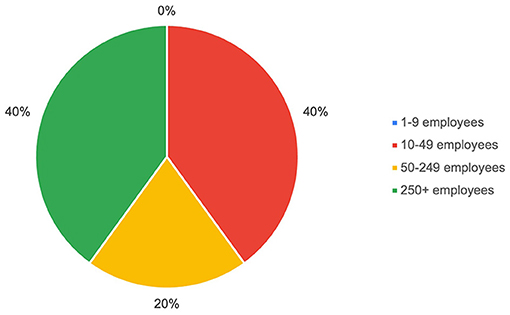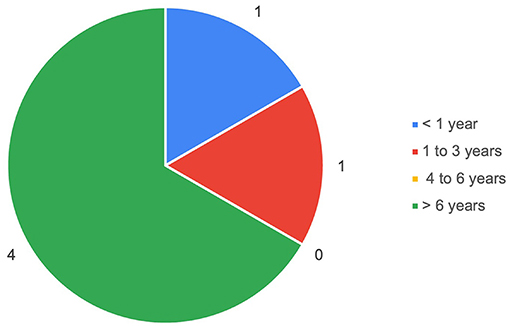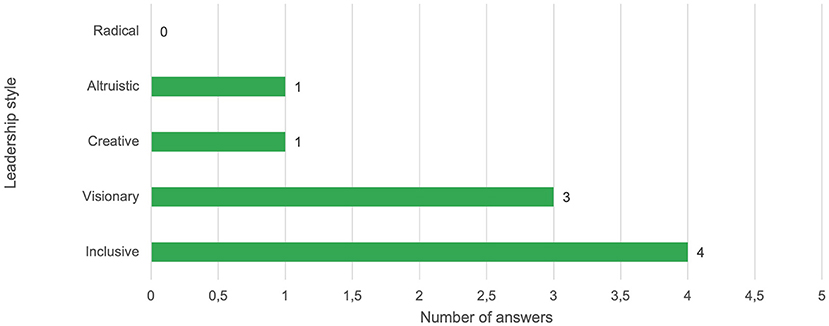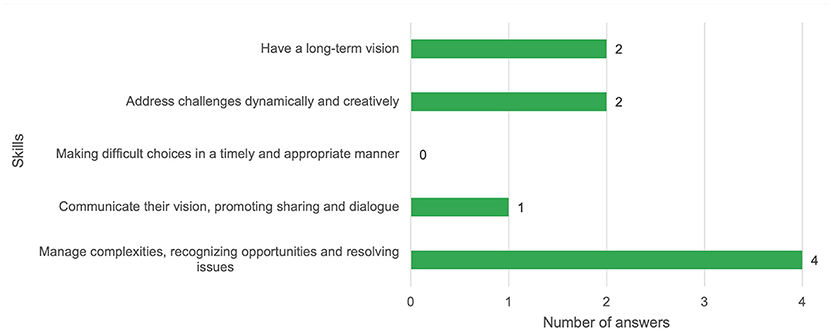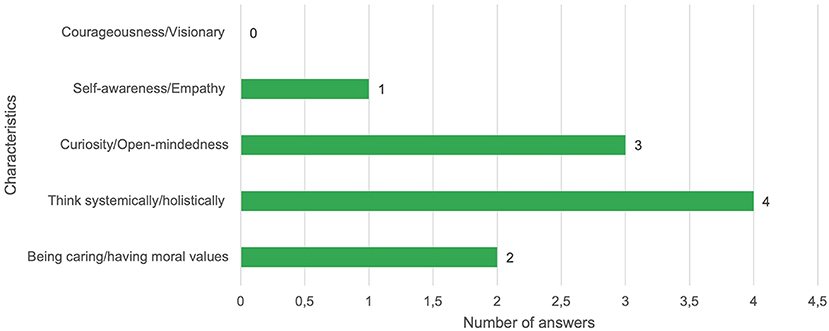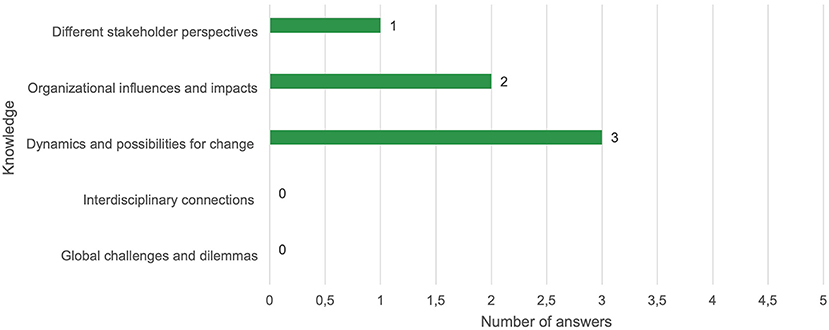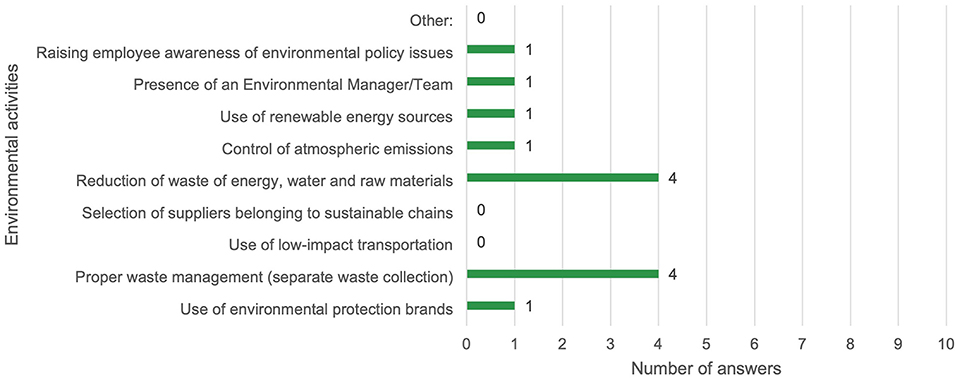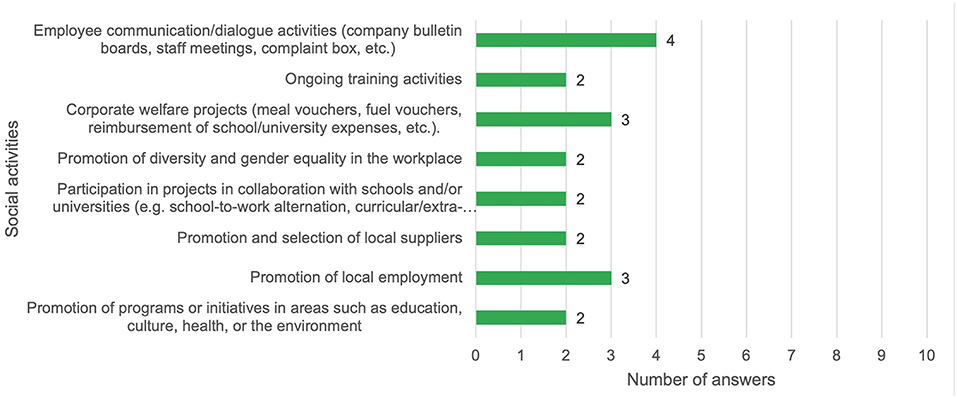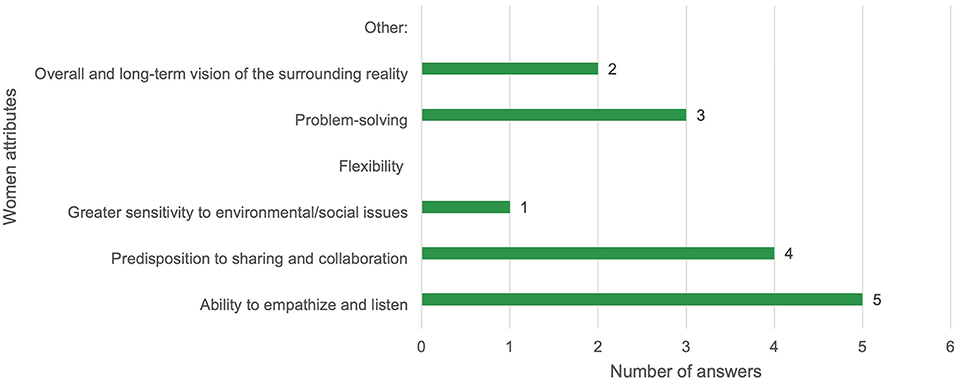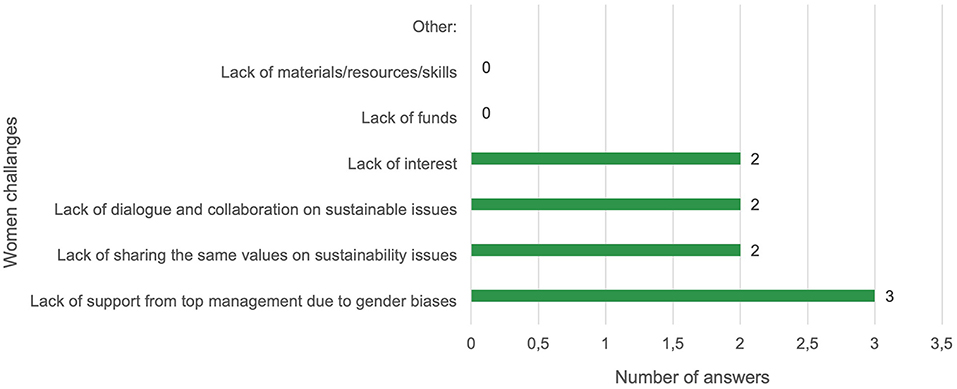- Department of Economics, Society, Politics, University of Urbino Carlo Bo, Urbino, Italy
The current political, economic and social scenario is characterized by continuous and rapid changes. Companies are therefore called to face a significant change, which requires the definition of policies and strategies strongly oriented toward sustainable development, becoming fundamental for long-term success and competitiveness. In this perspective, female leadership plays a key role. Over time, women have demonstrated the ability to successfully manage the challenges imposed by social dynamics and environmental change. Despite the growing number of studies on women as sustainable development leaders, there is still little empirical evidence on how women contribute to the to the companies' sustainable development. The paper aims to address this gap by developing a qualitative multiple case study based on the administration of questionnaires to five Italian companies characterized by the presence of women in leadership positions. Therefore, the objectives of the research work are: (i) to analyze how female leadership facilitates the company's transition toward sustainability; (ii) to define a “typical profile” of sustainable woman leader in terms of main characteristics, actions and challenges. Findings suggest that female leadership contributes to the promotion and implementation of environmental and social practices through several characteristics intrinsic to their nature, such as the ability to emphasize and listen and the predisposition to sharing and collaboration. In addition, sustainable women leaders exhibit the following main traits: thinking systematically/holistically, managing complexity, and inclusive approach to leadership. This study allows to enrich the literature related to the relationship between sustainability and female leadership, providing empirical evidence on the topic.
Introduction
The obvious changes that characterize the current economic, political and social scenario have prompted companies to question traditional business management models, which are excessively profit-oriented and less concerned with the needs of the community. Nowadays, the exclusive profit orientation is inadequate and potentially dangerous for the survival of the company, which cannot avoid the new and critical awareness assumed by the large number of stakeholders about the impacts generated by the company's activity in the surrounding context. The attention paid to the relations with the different social actors thus becomes a critical success factor and requires the integration of social needs into the company's strategies in order to achieve a lasting and defensible competitive advantage. In this perspective, the topic of sustainable development has gained increasing attention and has become the focus of an important political, academic and managerial debate (Wilkinson et al., 2001; Hall et al., 2010; Shinbrot et al., 2019).
The definition of sustainable development that is still widely accepted today is the one formulated in the Brundtland Report carried out in 1987 by the World Commission on Environment and Development (Schaefer and Crane, 2005). The report defines sustainable development as “development that meets the needs of the present generation without compromising the ability of future generations to meet their own needs” (World Commission on Environment Development, 1987, p. 43). This concept is the result of the greater awareness of the exhaustibility of the planet's resources and the consequent need to preserve the quality of the natural heritage (Fernández et al., 2021), through the definition of economic-social development models that are more balanced than those adopted in the past. Based on this, the three main dimensions of sustainable development are economic growth, environmental protection and social equality (Mensah, 2019; Milenković et al., 2021).
Over time, this concept has evolved profoundly and has taken on specific connotations depending on the context of application (Du Pisani, 2006; Bilan, 2013; Shi et al., 2019). At corporate level, the definition of strategies oriented toward sustainable development translates into the adoption of a three-dimensional approach that finds its expression in the so-called “Triple Bottom Line” of Elkington (1994), based on the integration of economic, social and environmental sustainability. In this view, the dimensions identified by the Triple Bottom Line are generally identified as the 3P (Slaper and Hall, 2011), namely:
(i) Profits—refers to the objectives of an economic nature, indispensable for the survival and development of the company itself;
(ii) People—refer to the social results that enable the company to meet the needs of the various stakeholders, implementing activities that contribute to the growth and wellbeing of society;
(iii) Planet—refers to the environmental objectives to which the company must pay attention in terms of ecological balance, trying to minimize environmental impact.
Companies are therefore called to face a significant change, which requires the definition of policies and strategies strongly oriented toward the joint pursuit of economic, social and environmental objectives, which are fundamental for long-term success and competitiveness. In this context, the leader figures are crucial, since their actions are an essential factor in guiding the enterprise toward a sustainable transformation (Metcalf and Benn, 2013).
“A leader is one or more people who selects, equips, trains, and influences one or more follower(s) who have diverse gifts, abilities, and skills and focuses the follower(s) to the organization's mission and objectives causing the follower(s) to willingly and enthusiastically expend spiritual, emotional, and physical energy in a concerted coordinated effort to achieve the organizational mission and objectives.” (Winston and Patterson, 2006, p. 7).
In fact, leadership can be considered as a social influence process (Omolayo, 2007), in which the leader seeks the voluntary participation of collaborators in an effort to achieve common goals. Although there are different approaches to the concept of leadership, scholars agree that the leader for sustainability must exhibit specific skills (Visser and Courtice, 2011; Metcalf and Benn, 2013; Tideman et al., 2013), such as motivating and engaging employees in the change process, emotional intelligence, and problem solving. According to McCann and Holt (2010), sustainability leadership is intended to be concerned with creating current and future benefits while improving the lives of all actors involved.
In this sense, women play a key role as promoters of a sustainability-focused approach. Throughout time, women have demonstrated their value and abilities in addressing the challenges imposed by social dynamics and environmental changes. For instance, several studies have explained how women are uniquely positioned as stewards of natural resources (Quisumbing et al., 2001; Nightingale, 2011). In 1992, the United Nations Conference on Environment and Development in Rio de Janeiro officially confirmed the position of women with respect to the future of sustainable development, stating in principle 20 that “women have a vital role in environmental management and development. Their full participation is therefore essential to achieve sustainable development” (Agenda 21, 1992; UN General Assembly, 1992). Women, in fact, have been shown to possess a number of characteristics embedded in their nature that makes their commitment to the sustainability issue much stronger than that of men (Zelezny et al., 2000; Fernández et al., 2021). According to Agarwal et al. (2020), women possess some crucial capacities to achieve sustainable change, such as innovative and creative perspective, leadership attitude, social awareness and a good ability to identify opportunities. Cicchiello et al. (2021) demonstrate that a higher percentage of women directors in the Board of Directors strengthens the adoption of Sustainable Development Goals' practices and external assurance of sustainability reporting. A study conducted by Galletta et al. (2022) in the banking industry shows that increasing the proportion of female directors improves financial and environmental performance because women are more attentive to the social dimension and stakeholders' expectations than men directors. Nevertheless, not all women have the same effect on a company's environmental performance. According to Issa et al. (2021), female directors with advanced education and a social engagement background are positively associated with sustainability performance.
Feminist scholarship on gender diversity indicates that women tend to have more altruistic and empathetic attitudes (Boulouta, 2013; Glass et al., 2016; Acevedo-Duque et al., 2021) than their male counterparts, showing particular concern for the wellbeing of others and caring for interpersonal relationships. The empirical analysis by Bulmer et al. (2021), realized in Spain, shows that the wellbeing of employees is a priority for women managers.
Such communal attributes are inevitably reflected in women's leadership style (Carli and Eagly, 2016) and become essential in fostering the transition to sustainable development. Women leaders appear to be more stakeholder and long-term oriented than men (Glass et al., 2016), who tend to adopt a shareholder and short-term orientation. For instance, women are better able to combine the interests of multiple stakeholders, including communities, employees, suppliers and customers, with the performance-based interests of shareholders (Brammer et al., 2007; Harrison and Coombs, 2012). Eagly et al. (2003) state that the female style exhibits optimism about goals and future states, new perspectives for solving problems and completing tasks and focuses on the development and mentoring of followers. The women's characteristics recall servant leadership which is leadership for the service of people and country (Sendjaya and Sarros, 2002; Gandolfi and Stone, 2018). Different studies also highlight that female leadership encourages the pursuit of innovative initiatives, while male leaders are more anchored in traditional practices (Eagly et al., 2003; Adams and Funk, 2012; Francis et al., 2021). Furthermore, women have unique leadership approaches to build trust among workers, focus on conflict resolution and facilitate collaboration (Westermann et al., 2005; Eagly and Carli, 2007), while men tend to adopt a dominant leadership style. Thus, women managers foster a diversity of perspectives and opinions (Weiner et al., 2019; Kadi-Montiel and Acevedo-Duque, 2021). Additionally, female leadership is characterized by an enterprising spirit, a capacity to build work teams, and the ability to make decisions in times of crisis (Acevedo-Duque et al., 2021). Women, inside the domestic context, are considered able to organize themselves, the ability to plan family activities, and facing to adversity (Vimal et al., 2021). All these abilities are fundamental characteristics of a manager. These common leadership traits contribute to make women more inclined to the implementation of social and environmental strategies, which presuppose a completely innovative and relational approach to business management. A sustainability-driven company defines its policies, strategies and actions on the basis of the stakeholders involved and the economic, social and environmental impact of its activities.
Despite the growing number of studies on women as sustainable development leaders, there is still little empirical evidence on how women contribute to the companies' sustainable development. This paper aims to address this gap by developing a qualitative multiple case study based on the administration of questionnaires to five Italian companies characterized by the presence of women in leadership positions. Thus, the research questions are the following:
(i) What are the main characteristics of a female sustainability leader?
(ii) What does a female sustainability leader implement the main actions?
(iii) What does a female sustainability leader face the main challenges?
The paper is organized as follows: Section Research Methodology describes the research methodology, Section Results presents the empirical results and Section Conclusions and Limitations discusses the main conclusions and limitations.
Research Methodology
We focus our attention on Italy because it is a country with a highly conservative gender culture (Maida and Weber, 2022). Italy's World Economic Forum, Global Gender Gap Report (2020) is equal to 0.707 (0.00 imparity, 1.00 parity), and it gets in 76 rank out of 153 countries. Italy is 117 rank in economic participation and opportunity according to the Global Gender Gap Index rankings by subindex (2020). Italy is 44 rank in political empowerment of women. Additionally, Italy is 19 in the global gender gap index ranking in the region “Western Europe and North America”. Only Greece, Malta, and Cyprus have a lower index.
Given the limited empirical evidence on the topic under study, the methodology of the multiple case study is very useful as it allows to understand contemporary phenomena and practices and to provide material on current issues that are still poorly known (Gummesson, 2002). We employed the multiple case study (Yin, 2009) based on five Italian companies with women in a leadership role to investigate how female leadership can contribute to company sustainability and define a “typical profile” of a sustainable woman leader.
According to Baxter and Jack (2008), this approach leads to a clearer comprehension and characterization of the phenomenon examined, providing a strong and reliable evidence. Moreover, the multiple case study enables a direct comparison between the cases highlighting the similarities and the differences.
The research method for this study is a mixed-method based (Creswell and Clark, 2017). Qualitative and quantitative data are included to answer research questions. We employed the questionnaire with open-ended questions and multiple-choice questions, and the website and two databases (Aida—Bureau Van Dijk; Atoka—Cerved Group). The triangulation of data (Patton, 1999) requests multiple data collection tools to provide depth to studying phenomena from various perspectives. Indeed, the adoption of different collection techniques is strongly encouraged for the reliability of the information, limiting the distortions, and ensuring a better study quality.
Case Studies
The questionnaire was addressed to women who hold a leadership position within the five companies included in the study. These firms operate in the Marche region and were selected since they play a crucial role in the development of the territory and are important examples of best practices for other companies in the market. Furthermore, they have been collaborating for years with universities in multiple research projects, demonstrating a growing attention to gender equality and sustainability issues.
Questionnaire
The survey is divided into four sections, as shown in Appendix Tables A1–A4. The questions are defined to address the research issues illustrated above and achieve the objectives of the study. Some of them are single-answer, some are multiple-answer and others are open-ended.
Data Collection and Analysis
The Google Form online tool was used to share the link to the survey. The estimated time to complete the questionnaire was 4–8 min and 6 responses were obtained from February 2022 to April 2022. The women surveyed hold the positions of Head of Line, Head of Product Development, Head of Sales or Head of Administration. The results were analyzed through descriptive statistics and were then triangulated with secondary data (i.e., website, Atoka—Cerved Group, Aida—Bureau van Dijk) to complete the description of the company profile.
Results
The following paragraphs outline the results obtained from the survey conducted. To this end, this section has been divided into four parts, following the structure of the questionnaire. In this perspective, the first section presents the general characteristics of the five companies investigated. The second section analyzes the sustainability female leaders of the firms under study in terms of leadership styles, skills, attributes and knowledge. The third section describes the sustainability actions implemented by these women leaders. Finally, the fourth section focuses on the typical female traits that foster the implementation of sustainable business strategies and the challenges female leaders face in this regard.
Company Profiles
All of the companies analyzed operate in the manufacturing sector and have been on the market for over 21 years. In addition, most of them are large (2 out of 5 companies) and small (2 out of 5 companies), while only one company is classified as a medium-sized company (Figure 1).
Table 1 summarizes the data of the five companies with reference to negative events (it considers various negative events, including protests, prejudicial events, bankruptcies, insolvency proceedings; the score takes into account the age and type of negative event, the current state of the event, the type of subject and the type of link) innovativeness score (it is given to companies based on the content of their websites that measures the innovativeness factors of the company. The score is normalized using the percentile method: a score of 60 means that the company has a raw score higher than 60% of the companies), foreign propensity score (it measures the interest of a company to have relations with foreign markets. The companies for which we have evidence of foreign relations fall into the “certain” class and have a score equal to 100. For the others, a machine learning model allows us to estimate a value between 0 and 99, where the class is related to the score distribution), company age, revenues and number of employees.
Being a Female Sustainability Leader
As illustrated in Figure 2, the majority of female respondents have been in a leadership position for more than 6 years (4 out of 6 women), the remaining two women have been leaders for <3 and 1 years, respectively. Furthermore, they confirm the presence of other female leaders, which, however, are <10% across investigated companies.
The leadership styles that best describe the approach to sustainability of the women involved in the study are the inclusive and visionary ones, which were each selected 4 and 3 times (Figure 3). The creative and altruistic options were chosen only once, while the radical style was never selected.
The ability to manage complexities is considered by most of the women leaders responding (4 out of 6) as critical to leading the firm in a sustainability-oriented approach (Figure 4). Long-term vision and knowing how to address challenges dynamically and creatively are also skills considered important by leaders analyzed who selected these options twice in both cases. Less emphasis was placed on vision communication and making difficult choices in a timely and appropriate manner, which were chosen 1 and 0 times, respectively.
Figure 5 shows that thinking systematically/holistically and curiosity/open-mindedness are the characteristics that best describe the approach to sustainability adopted by the women leaders of the companies surveyed, who chose these answers 4 and 3 times. Being caring/having moral values and self-awareness/empathy were selected only in 2 and 1 cases, while courageousness/visionary was never chosen.
Finally, half of the women leaders surveyed felt that knowledge of the dynamics and possibilities for change should be possessed by a sustainable leader, while 2 out of 6 women leaders believed that knowledge of organizational influences and impacts is important (Figure 6). On the other hand, knowledge of different stakeholder perspectives and knowledge of global challenges and dilemmas were selected only once.
Acting as a Female Sustainability Leader
As regards the environmental dimension, the main activities implemented by the sustainable women leaders concern the correct management of waste (4 out of 6) and the reduction of waste of energy, water and raw materials (4 out of 6) (Figure 7). The selection of suppliers belonging to sustainable chains and the use of low-impact transportation are not implemented by any of the women leaders under study. The remaining environmental actions, on the other hand, are promoted by at least one of the female leaders called to answer the questionnaire.
As indicated in Figure 8, all the women leaders of the five companies analyzed implement at least one of the social activities listed in the questionnaire. Employee communication/dialogue activities is the most promoted action; in fact, it is implemented by 4 out of 6 women leaders. Corporate welfare projects and the promotion of local employment are implemented by 3 women leaders, while the other activities are promoted by at least 2 female leaders.
In addition, women leaders at 4 out of 5 companies promoted the adoption of corporate certifications. Specifically, all 4 certified companies hold ISO 9001 quality certification, 3 companies have ISO 14001 environmental certification, and only one company holds ISO 45001 occupational health and safety certification. Three women leaders also say they have ongoing projects related to improving waste management and using renewable energy sources and smart working.
Contributions and Challenges of a Female Sustainability Leader
The ability to emphasize and listen and the predisposition to sharing and collaboration are considered the two typical traits of female leadership that are ablest to increase the effectiveness of implementing sustainable development strategies. In fact, these attributes were chosen, respectively, by 5 and 4 women leaders out of a total of 6 (Figure 9). Even the overall and long-term vision of the surrounding reality (2 out of 6) and the problem solving (3 out of 6) are considered natural female characteristics capable of facilitating the implementation of sustainable strategies within the companies examined. On the contrary, greater sensitivity to environmental issues has been selected only one time, while flexibility is not among the typical female attributes considered instrumental to the success of business sustainability.
As shown in Figure 10, half of the women leaders surveyed (3 out of 6) believe that the lack of support from top management due to gender biases is the main obstacle to be faced by a female leadership oriented toward sustainable development. The lack of dialogue, collaboration, interest and sharing of the same values on sustainability are also considered obstacles to the success of a sustainable female leadership (each selected 2 times out of 6). The lack of funds or materials/resources/skills were never mentioned.
At the end of the questionnaire, 4 of the 6 women leaders suggest the importance of introducing training and awareness activities on the sustainability issue and the role of women within the company, in order to be able to promptly face the challenges of the radical change already underway.
Conclusions and Limitations
The main objectives of the study were to understand how women leaders contribute to corporate sustainability and to define a “typical profile” of a sustainable woman leader. In this sense, it allows to enrich the literature related to the relationship between sustainability and female leadership, providing empirical evidence on the topic. As stated by Fernández et al. (2021), there is still a lack of empirical studies on the impact that women leaders have on sustainable business transformation.
Specifically, the findings show that women leaders contribute to the sustainability of the five companies through several characteristics intrinsic to their nature, such as the ability to emphasize and listen and the predisposition to sharing and collaboration. Such evidence helps to support the theoretical framework of different scholars, who state that women tend to have altruistic and empathetic behavior and promote collaboration among workers (Westermann et al., 2005; Eagly and Carli, 2007; Boulouta, 2013; Glass et al., 2016; Acevedo-Duque et al., 2021). However, women still encounter difficulties in fulfilling their role as sustainable leaders, among which the lack of support due to gender stereotypes comes first. This problem was felt most in the smaller companies highlighting a lower sensitivity on gender parity than in larger firms.
The study also allowed to identify the main characteristics, skills and leadership styles of female leaders. In this way, it is possible to define a profile of sustainable women leaders with the following traits: thinking systematically/holistically, managing complexity, and inclusive approach to leadership (Weiner et al., 2019; Acevedo-Duque et al., 2021; Kadi-Montiel and Acevedo-Duque, 2021). In addition, it was found that the main actions implemented by the women leaders surveyed are waste of energy, water and raw materials and proper waste management with regard to the environmental dimension (Quisumbing et al., 2001; Nightingale, 2011), employee communication/dialogue activities, corporate welfare projects and promotion of local employment with respect to the social component (Galletta et al., 2022). Concerning these actions, it is important to point out that they do not depend exclusively on the women leaders surveyed but are the result of decisions made at the corporate governance level. Furthermore, it is possible to note that both environmental and social activities are mainly implemented within the large and medium-sized companies analyzed. This result would seem to confirm the difficulty that small Italian enterprises still face in sustainable transformation, such as the lack of financial and human resources (Iraldo et al., 2011). Finally, the analysis has helped to highlight the important role played by women leaders in promoting and implementing environmental and social practices, encouraging the transition to more sustainable business models.
The implications are relevant. Women leaders can contribute to sustainability; consequently, the political efforts oriented toward gender equality will probably have positive effects also in terms of sustainability. This link will have to be investigated. Thus, the role of female leaders deserves our attention, mainly in a context as Italian context where the culture is anchored to gender stereotypes and the companies are principally small and medium-sized enterprises, with a lack of resources and a significant gender gap.
The research presents some limitations. First, the empirical analysis is limited to only five companies that belong to a specific region of Italy. In addition, the questionnaire was filled out exclusively by female leaders. To further validate the results, it could be interesting to increase the number of companies, also considering other geographic areas and including male leaders. In this way, multiple contexts can be considered and the different approaches of male and female leaders to sustainability can be compared and analyzed.
Data Availability Statement
The raw data supporting the conclusions of this article will be made available by the authors, without undue reservation.
Ethics Statement
Ethical review and approval was not required for the study on human participants in accordance with the local legislation and institutional requirements. The patients/participants provided their written informed consent to participate in this study.
Author Contributions
GP, FM, and FP: introduction, research methodology, results, conclusion, and limitations. All authors contributed to the article and approved the submitted version.
Conflict of Interest
The authors declare that the research was conducted in the absence of any commercial or financial relationships that could be construed as a potential conflict of interest.
Publisher's Note
All claims expressed in this article are solely those of the authors and do not necessarily represent those of their affiliated organizations, or those of the publisher, the editors and the reviewers. Any product that may be evaluated in this article, or claim that may be made by its manufacturer, is not guaranteed or endorsed by the publisher.
Supplementary Material
The Supplementary Material for this article can be found online at: https://www.frontiersin.org/articles/10.3389/frsus.2022.930116/full#supplementary-material
References
Acevedo-Duque, Á., Gonzalez-Diaz, R., Vargas, E.C., Paz-Marcano, A., Muller-Pérez, S., Salazar-Sepúlveda, G., et al. (2021). Resilience, leadership and female entrepreneurship within the context of smes: evidence from Latin America. Sustainability 13, 8129. doi: 10.3390/su13158129
Adams, R. B., and Funk, P. (2012). Beyond the glass ceiling: does gender matter? Manag. Sci. 58, 219–235. doi: 10.1287/mnsc.1110.1452
Agarwal, S., Lenka, U., Singh, K., Agrawal, V., and Agrawal, A. M. (2020). A qualitative approach towards crucial factors for sustainable development of women social entrepreneurship: Indian cases. J. Clean. Prod. 274, 123135. doi: 10.1016/j.jclepro.2020.123135
Agenda 21 (1992). Programme of Action for Sustainable Development; Rio Declaration on Environment and Development; Statement of Forest Principles: The Final Text of Agreements Negotiated by Governmental at the United Nations Conference on Environment and Development (UNCED), Rio De Janeiro, Brazil. New York, NY: United National Department of Public Information, 1993.
Baxter, P., and Jack, S. (2008). Qualitative case study methodology: Study design and implementation for novice researchers. Qualit. Rep. 13, 544–559. Available online at: https://nsuworks.nova.edu/tqr/vol13/iss4/2/
Bilan, Y. (2013). Sustainable development of a company: Building of new level relationship with the consumers of XXI century. Amfiteatru Econ. J. 15, 687–701. Available online at: http://hdl.handle.net/10419/168808
Boulouta, I. (2013). Hidden connections: the link between board gender diversity and corporate social performance. J. Busin. Ethics 113, 185–197. doi: 10.1007/s10551-012-1293-7
Brammer, S., Millington, A., and Pavelin, S. (2007). Gender and ethnic diversity among UK corporate boards. Corp. Govern. Int. Rev. 15, 393–403. doi: 10.1111/j.1467-8683.2007.00569.x
Bulmer, E., Riera, M., and Rodríguez, R. (2021). The importance of sustainable leadership amongst female managers in the Spanish logistics industry: a cultural, ethical and legal perspective. Sustainability 13, 6841. doi: 10.3390/su13126841
Carli, L. L., and Eagly, A. (2016). Women face a labyrinth: an examination of metaphors for women leaders. Gender Manag. 31, 514–527. doi: 10.1108/GM-02-2015-0007
Cicchiello, A. F., Fellegara, A. M., Kazemikhasragh, A., and Monferrà, S. (2021). Gender diversity on corporate boards: How Asian and African women contribute on sustainability reporting activity. Gender Manag. 36, 801–820. doi: 10.1108/GM-05-2020-0147
Creswell, J. W., and Clark, V. L. P. (2017). Designing and Conducting Mixed Methods Research. Thousand Oaks, CA: SAGE Publications.
Du Pisani, J. A. (2006). Sustainable development–historical roots of the concept. Environ. Sci. 3, 83–96. doi: 10.1080/15693430600688831
Eagly, A. H., and Carli, L. L. (2007). Through the Labyrinth: The Truth About How Women Become Leaders. Boston, MA: Harvard Business School Press.
Eagly, A. H., Johannesen-Schmidt, M. C., and Van Engen, M. L. (2003). Transformational, transactional, and laissez-faire leadership styles: a meta-analysis comparing women and men. Psychol. Bull. 129, 569–591. doi: 10.1037/0033-2909.129.4.569
Elkington, J. (1994). Towards the sustainable corporation: win-win-win business strategies for sustainable development. Califor. Manag. Rev. 36, 90–100. doi: 10.2307/41165746
Fernández, M. B., García-Centeno, M. C., and Calderón Patier, C. (2021). Women sustainable entrepreneurship: review and research agenda. Sustainability 13, 12047. doi: 10.3390/su132112047
Francis, B. B., Hasan, I., Shen, Y. V., and Wu, Q. (2021). Do activist hedge funds target female CEOs? The role of CEO gender in hedge fund activism. J. Financ. Econ. 141, 372–393. doi: 10.1016/j.jfineco.2020.07.019
Galletta, S., Mazzù, S., Naciti, V., and Vermiglio, C. (2022). Gender diversity and sustainability performance in the banking industry. Corpor. Soc. Respons. Environ. Manag. 29, 161–174. doi: 10.1002/csr.2191
Gandolfi, F., and Stone, S. (2018). Leadership, leadership styles, and servant leadership. J. Manag. Res. 18, 261–269.
Glass, C., Cook, A., and Ingersoll, A. R. (2016). Do women leaders promote sustainability? Analyzing the effect of corporate governance composition on environmental performance. Busin. Strat. Environ. 25, 495–511. doi: 10.1002/bse.1879
Gummesson, E. (2002). Total Relationship Marketing: Marketing Management, Relationship Strategy and CRM Approaches for the Network Economy. 2nd Edn. Oxford: Butterworth-Heinemann.
Hall, J. K., Daneke, G. A., and Lenox, M. J. (2010). Sustainable development and entrepreneurship: past contributions and future directions. J. Busin. Ventur. 25, 439–448. doi: 10.1016/j.jbusvent.2010.01.002
Harrison, J. S., and Coombs, J. E. (2012). The moderating effects from corporate governance characteristics on the relationship between available slack and community-based firm performance. J. Busin. Ethics 107, 409–422. doi: 10.1007/s10551-011-1046-z
Iraldo, F., Testa, F., Melis, M., and Frey, M. (2011). A literature review on the links between environmental regulation and competitiveness. Environ. Policy Govern. 21, 210–222. doi: 10.1002/eet.568
Issa, A., Zaid, M. A. A., and Hanaysha, J. R. (2021). Exploring the relationship between female director's profile and sustainability performance: evidence from the Middle East. Manag. Decis. Econ. doi: 10.1002/mde.3503. [Epub ahead of print].
Kadi-Montiel, O., and Acevedo-Duque, A. (2021). Liderazgo ético frente a la diversidad cultural dentro de las organizaciones con regimen disciplinario. Económicas CUC 35, 75–88. Available online at: http://hdl.handle.net/11323/2724
Maida, A., and Weber, A. (2022). Female leadership and gender gap within firms: Evidence from an Italian board reform. ILR Rev. 75, 488–515. doi: 10.1177/0019793920961995
McCann, J. T., and Holt, R. A. (2010). Defining sustainable leadership. Int. J. Sustain. Strat. Manag. 2, 204–210. doi: 10.1504/IJSSM.2010.032561
Mensah, J. (2019). Sustainable development: meaning, history, principles, pillars, and implications for human action: literature review. Cogent Soc. Sci. 5, 1653531. doi: 10.1080/23311886.2019.1653531
Metcalf, L., and Benn, S. (2013). Leadership for sustainability: an evolution of leadership ability. J. Busin. Ethics 112, 369–384. doi: 10.1007/s10551-012-1278-6
Milenković, M., Vaseashta, A., and Vasović, D. (2021). Strategic planning of regional sustainable development using factor analysis method. Polish J. Environ. Stud. 30, 1317–1323. doi: 10.15244/pjoes/124752
Nightingale, A. J. (2011). Bounding difference: intersectionality and the material production of gender, caste, class and environment in Nepal. Geoforum 42, 153–162. doi: 10.1016/j.geoforum.2010.03.004
Omolayo, B. (2007). Effect of leadership style on job-related tension and psychological sense of community in work organizations: a case study of four organizations in Lagos State, Nigeria. Bangl. e-J. Sociol. 4, 30–37.
Patton, M. Q. (1999). Enhancing the quality and credibility of qualitative analysis. Health Serv. Res. 34, 1189–1208.
Quisumbing, A. R., Haddad, L., and Peña, C. (2001). Are women overrepresented among the poor? An analysis of poverty in 10 developing countries. J. Dev. Econ. 66, 225–269. doi: 10.1016/S0304-3878(01)00152-3
Schaefer, A., and Crane, A. (2005). Addressing sustainability and consumption. J. Macromark. 25, 76–92. doi: 10.1177/0276146705274987
Sendjaya, S., and Sarros, J. C. (2002). Servant leadership: its origin, development, and application in organizations. J. Leader. Organ. Stud. 9, 57–64. doi: 10.1177/107179190200900205
Shi, L., Han, L., Yang, F., and Gao, L. (2019). The evolution of sustainable development theory: types, goals, and research prospects. Sustainability 11, 7158. doi: 10.3390/su11247158
Shinbrot, X. A., Wilkins, K., Gretzel, U., and Bowser, G. (2019). Unlocking women's sustainability leadership potential: perceptions of contributions and challenges for women in sustainable development. World Dev. 119, 120–132. doi: 10.1016/j.worlddev.2019.03.009
Slaper, T. F., and Hall, T. J. (2011). The triple bottom line: what is it and how does it work. Indiana Bus. Rev. 86, 4–8. Available online at: http://www.ibrc.indiana.edu/ibr/2011/spring/article2.html
Tideman, S. G., Arts, M. C., and Zandee, D. P. (2013). Sustainable leadership: towards a workable definition. J. Corp. Citizenship 49, 17–33. doi: 10.9774/GLEAF.4700.2013.ma.00004
UN General Assembly (1992). Rio Declaration on Environment and Development. Rio de Janeiro: United National Conference on Environment and Development.
Vimal, K. E. K., Kandasamy, J., and Duque, A. A. (2021). Integrating sustainability and remanufacturing strategies by remanufacturing quality function deployment (RQFD). Environ. Dev. Sustain. 23, 1–33. doi: 10.1007/s10668-020-01211-0
Visser, W., and Courtice, P. (2011). Sustainability Leadership: Linking Theory and Practice. Available at: https://ssrn.com/abstract=1947221 (accessed February 2, 2022).
Weiner, J. M., Cyr, D., and Burton, L. J. (2019). Microaggressions in administrator preparation programs: how black female participants experienced discussions of identity, discrimination, and leadership. J. Res. Leadersh. Educ. 16, 1942775119858655. doi: 10.1177/1942775119858655
Westermann, O., Ashby, J., and Pretty, J. (2005). Gender and social capital: the importance of gender differences for the maturity and effectiveness of natural resource management groups. World Dev. 33, 1783–1799. doi: 10.1016/j.worlddev.2005.04.018
Wilkinson, A., Hill, M., and Gollan, P. (2001). The sustainability debate. Int. J. Operat. Prod. Manag. 21, 1492–1502. doi: 10.1108/01443570110410865
Winston, B. E., and Patterson, K. (2006). An integrative definition of leadership. Int. J. Leader. Stud. 1. 6–66.
World Commission on Environment and Development (1987). Our Common Future. Oxford: Oxford University Press.
World Economic Forum Global Gender Gap Report. (2020). Available online at: https://www.weforum.org/reports/gender-gap-2020-report-100-years-pay-equality/ (accessed May 18, 2022).
Keywords: women, leadership, business sustainability, gender, sustainable development
Citation: Pierli G, Murmura F and Palazzi F (2022) Women and Leadership: How Do Women Leaders Contribute to Companies' Sustainable Choices? Front. Sustain. 3:930116. doi: 10.3389/frsus.2022.930116
Received: 27 April 2022; Accepted: 01 June 2022;
Published: 05 July 2022.
Edited by:
Maria Francesca Renzi, Roma Tre University, ItalyReviewed by:
Eliana Andréa Severo, Federal University of Pernambuco, BrazilIzabela Jonek-Kowalska, Silesian University of Technology, Poland
Copyright © 2022 Pierli, Murmura and Palazzi. This is an open-access article distributed under the terms of the Creative Commons Attribution License (CC BY). The use, distribution or reproduction in other forums is permitted, provided the original author(s) and the copyright owner(s) are credited and that the original publication in this journal is cited, in accordance with accepted academic practice. No use, distribution or reproduction is permitted which does not comply with these terms.
*Correspondence: Federica Murmura, ZmVkZXJpY2EubXVybXVyYUB1bml1cmIuaXQ=
 Giada Pierli
Giada Pierli Federica Murmura
Federica Murmura Federica Palazzi
Federica Palazzi